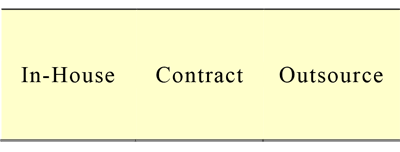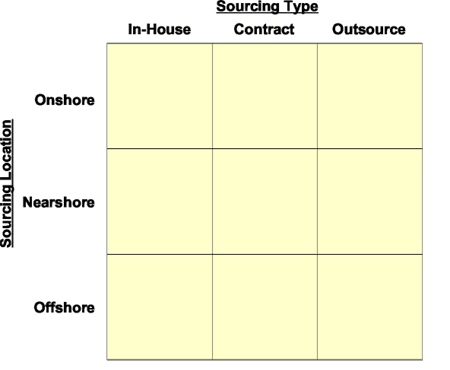 By Jeff Richards
By Jeff Richards
Managing Partner
Thanks to the wonders of technology and transportation, today many (if not most) business processes can be performed almost anywhere in the world. As a result, your organization has countless options for global sourcing – so much so that analyzing all of the options can be challenging.
To assist you in this area, CIOPS has developed a matrix that serves as a succinct strategic framework for illustrating your global sourcing alternatives. Here’s what you need to know…
There are three main sourcing types
Who will do the work? There are three main sourcing types – in-house, contract and outsource – and these alternatives form the columns in the strategic global sourcing framework.

- In-House – The work is done by your own full-time or part-time employees, and your company maintains complete expertise and control in all aspects of the work.
- Contract – The work is done by contract workers, and your company is responsible for managing and directing their efforts. In many cases your company also pays for computers, telephones and other assets used in their work.
- Outsource – The work is done by an external organization. Depending on how the agreement is structured, the outsourcers may be responsible for the results as well as the required tasks. In general, outsourcers are usually self-managed and use their own assets to perform the work.
Of the three, outsourcing has the greatest possibility for cost savings.
There are three categories of sourcing locations
At one time, most manufacturing by U.S. companies was done in the U.S. Now it is performed worldwide, allowing companies to take advantage of lower labor costs, proximity to markets and other factors. With advances in enabling technologies, many business processes can also be performed anywhere in the world, too.
In analyzing global sourcing options, we segment geographic locations into three categories, all defined by their relationship to the U.S.: onshore, nearshore and offshore. These geographic locations form the rows in the strategic framework.

- Onshore – Refers to locations within the U.S.
- Nearshore – Refers to two types of locations. Most commonly, “nearshore” refers to locations in the same time zone or within close proximity, perhaps with a different language involved. In some cases “nearshore” can also mean locations outside of U.S. time zones where the language and culture are similar to the U.S, such as Northern Ireland and Australia.
- Offshore – Offshore sites include India, China, Russia and other countries in different time zones, which speak different languages and have different cultures and considerable geographic separation from the U.S.
Although the cost of nearshore alternatives may be higher, using them has advantages versus offshore providers. These include easier access by U.S. companies due to geographic proximity and fewer perceived risks (e.g., language and cultural barriers, and more familiar and similar laws).
Using the Global Sourcing Matrix
Assembling the sourcing types as columns and the sourcing locations as rows yields a 3 x 3 matrix that can be used to illustrate who performs processes, where those processes are performed, and the relationships between your company and your service providers. Using this framework allows situations to be described quickly and also shows how changes in an organization’s capabilities may be needed.

In using this matrix, there are a few things that you should keep in mind:
- All cells in the matrix represent valid sourcing strategies if you reside there intentionally.
- Movement among the cells is possible. Your relationships with service providers should be flexible, either by initial design in the contract or through evolution.
- Misunderstandings can be expensive. Often companies intend to enter into an outsourcing agreement with an offshore service provider but actually end up with an offshore contract agreement. In these situations the companies spend more time managing the offshore service provider than originally anticipated, eroding much of the planned cost savings.
Conclusion
The Global Sourcing Matrix can help simplify what can be a very complex subject. If you need help with your global sourcing strategy, give us a call.
About Jeff Richards
As an inspirational leader with the ability to develop the “big picture” strategy then drive it down to executable tactics for implementation, Jeff leads our Professional Services team. Clients benefit from Jeff’s 25+ years of experience developing and implementing transformative business strategies.
Jeff’s experience spans both industry (including Materials, Operations and IT Management) and consulting. He developed a unique global perspective during his tenure in significant P&L management-level positions in both Asia and Europe.
About CIO Professional Services
CIO Professional Services LLC is a top-rated IT (Information Technology) consulting firm, based in the San Francisco Bay Area, specializing in strategic IT consulting and business / IT alignment. Companies come to us seeking assistance with their information technology strategy as well as to source interim CIO / CTO employees or fractional CIO / CTOs.


